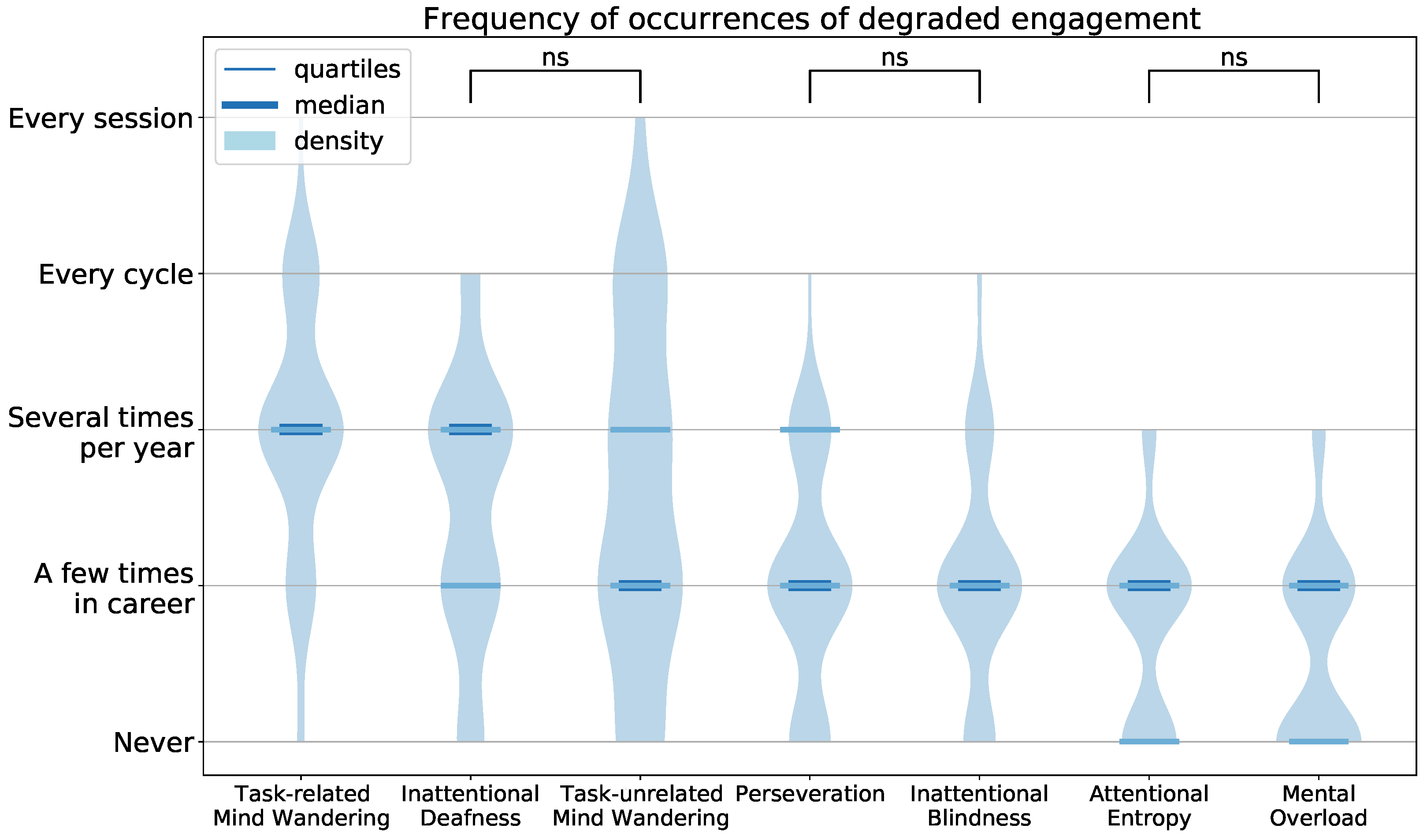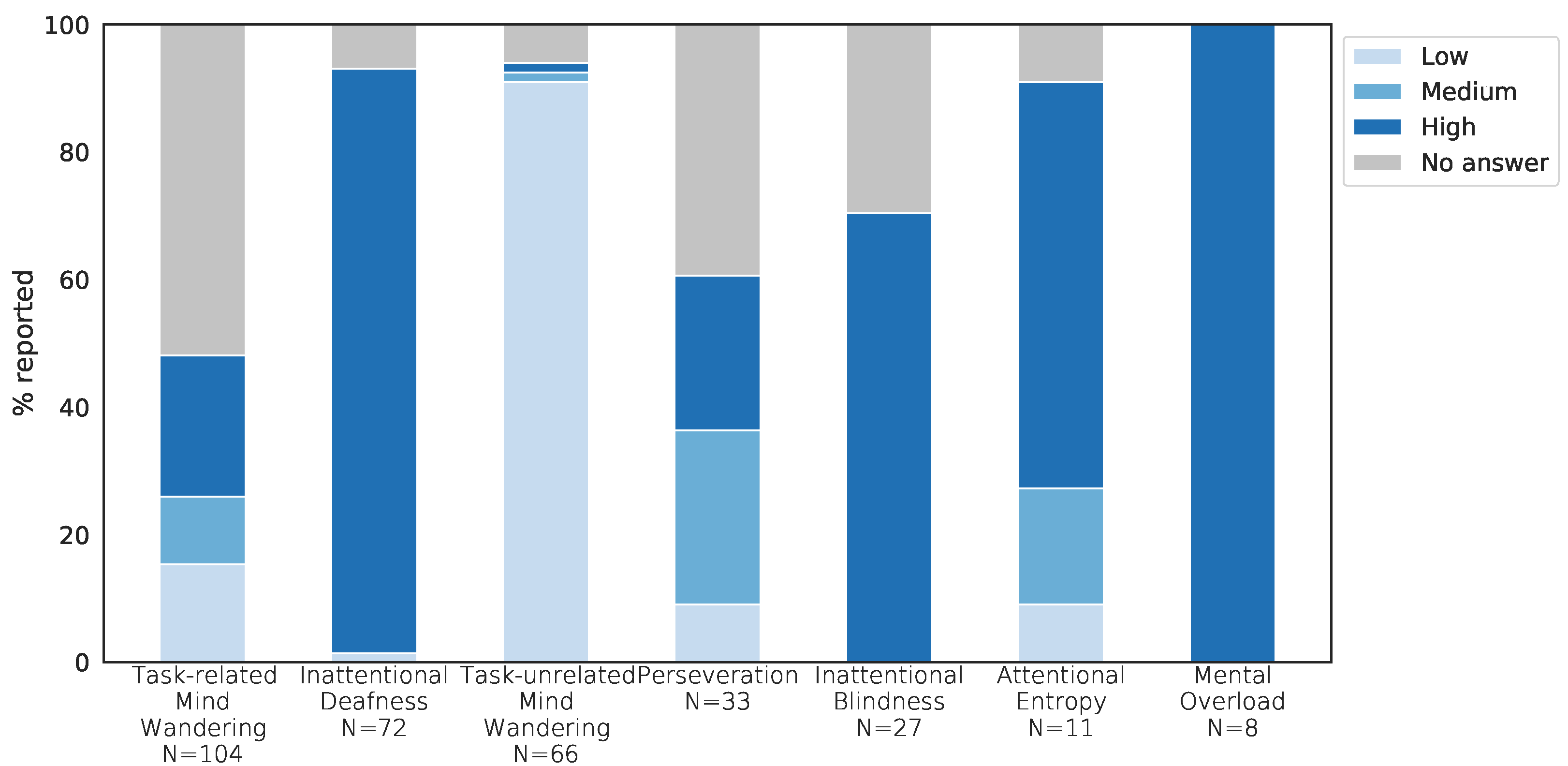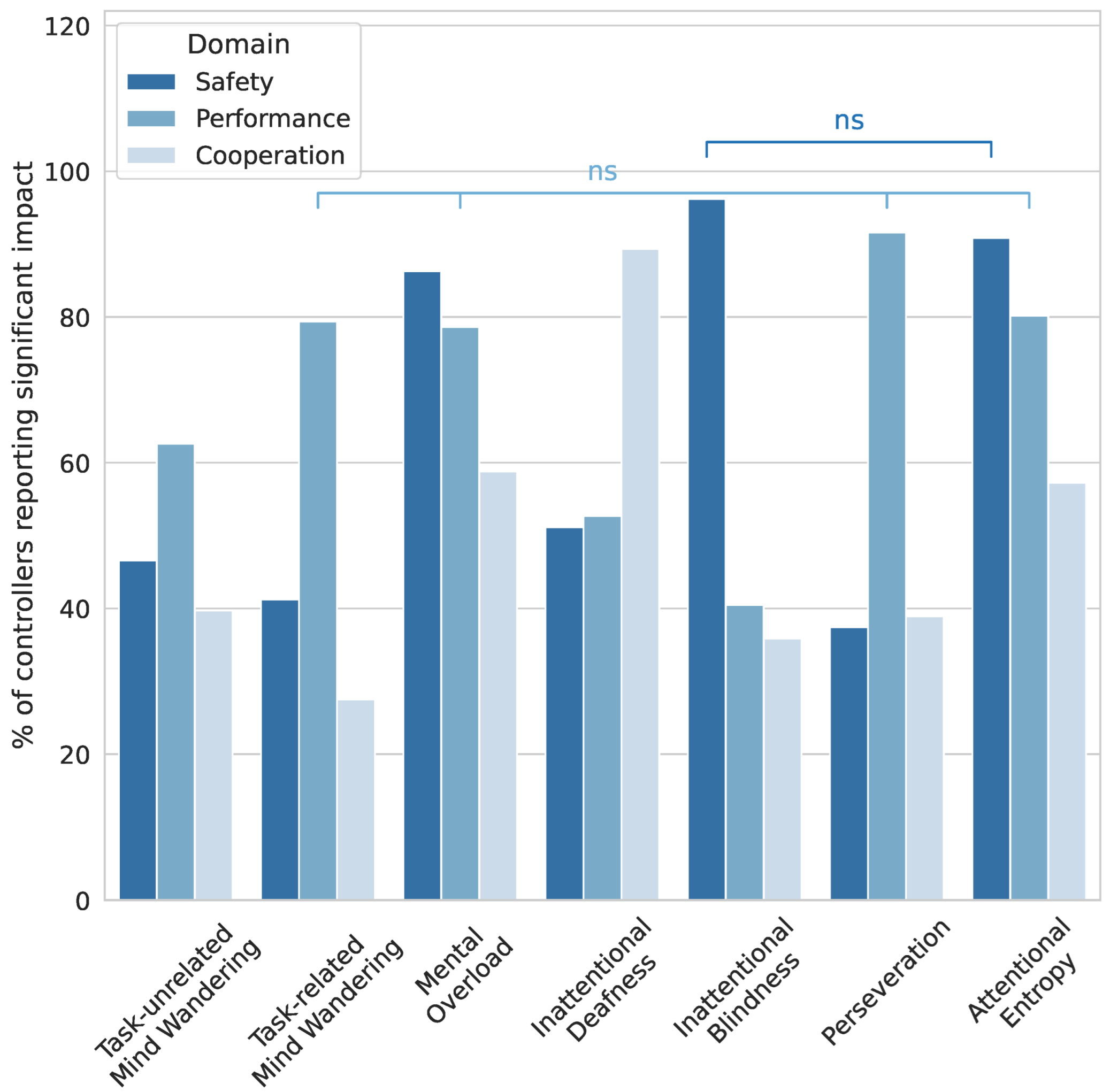Degraded States of Engagement in Air Traffic Control
Abstract
1. Introduction
2. Method
2.1. Participants
2.2. Procedure
2.3. Materials
2.4. Data Collection and Analysis
3. Results
3.1. Experiences of Degraded Engagement
3.2. Workload Experienced during Degraded States
3.3. Time of Occurrence of Degraded Attentional States
3.4. Impact of Degraded States on the Controllers’ Activity
4. Discussion
- All degraded states of engagement were experienced by air traffic controllers, and all these states can have a significant impact;
- States of over-engagement had fairly low prevalence but a high perceived impact, making them a prime target for future studies;
- These results advocate for the implementation of countermeasures to degraded attentional states in order to maintain a high level of safety, cooperation and performance.
4.1. Limitations
4.2. Perspectives
5. Conclusions
Author Contributions
Funding
Institutional Review Board Statement
Informed Consent Statement
Data Availability Statement
Acknowledgments
Conflicts of Interest
Appendix A
- Task-unrelated mind wandering:Did it ever happen that your thoughts disconnected from the present traffic and “wander” towards topics unrelated to air traffic control ?
- Task-related mind wandering:Did you ever integrate a new flight by browsing through its parameters without being concentrated on it, and realize later that your integration was so incomplete that you had to perform it again?
- Inattentional deafness:Did it ever happen that you were totally focused your radar screen and did not perceive verbal coordinations directed at you? For example, you did not the coordinations from your planning controller or information from the supervisor.
- Inattentional blindness:Did it ever happen that you were totally focused your radar screen and did not perceive, or belatedly perceive other signals elsewhere on the screen, such as a Short Term Conflict Alert or a newly added tag on a label?
- Perseveration:Did you ever get involved for several minutes in an obviously costly strategy (for example, solving a conflict with evolving aircraft with numerous heading instructions), while external elements (slow reactions from a pilot, many radio calls from other pilots, advice from your PC) urged you to switch to a simpler solution (for example, stopping a climb)?
- Attentional entropy:Did you ever fail to (or wrongly) anticipate the general situation in your sector and the forthcoming problems, and felt "lost" on the sector?
- Mental Overload:Did it ever happen that you could not handle all the incoming problems on the sector, even with a lot of effort ?
Appendix B
| Degraded State | Value | t | p | |
|---|---|---|---|---|
| Task unrelated Mind Wandering | −0.05 | 0.02 | −2.06 | 0.04 |
| Task related Mind Wandering | 0.03 | 0.02 | 1.17 | 0.24 |
| Mental overload | 0.02 | 0.02 | 0.66 | 0.51 |
| Inattentional Deafness | −0.00 | .02 | −0.19 | 0.85 |
| Inattentional Blindness | 0.05 | 0.02 | 1.85 | 0.06 |
| Perseveration | −0.02 | 0.02 | −0.86 | 0.39 |
| Attentional Entropy | 0.05 | 0.02 | 1.86 | 0.06 |
References
- EUROCONTROL. Performance Review Report 2019; Technical Report; Eurocontrol: Brussels, Belgium, 2020. [Google Scholar]
- EUROCONTROL. EUROCONTROL Five-Year Forecast 2020–2024; Technical Report; EUROCONTROL: Brussels, Belgium, 2021. [Google Scholar]
- International Civil Aviation Organization. Annex 11 to the Convention on International Civil Aviation; International Civil Aviation Organization: Montreal, QC, Canada, 2018. [Google Scholar]
- Pape, A.M.; Wiegmann, D.A.; Shappell, S. Air Traffic Control Related Accidents and Incidents: A Human Factors Analysis. In Proceedings of the 11th International Symposium on Aviation Psychology, Columbus, OH, USA, 5–8 March 2001. [Google Scholar]
- Stager, P.; Hameluck, D. Ergonomics in Air Traffic Control. Ergonomics 1990, 33, 493–499. [Google Scholar] [CrossRef]
- Shorrock, S.T. Errors of Perception in Air Traffic Control. Saf. Sci. 2007, 45, 890–904. [Google Scholar] [CrossRef]
- Scarborough, A.; Bailey, L.; Pounds, J. Examining ATC Operational Errors Using the Human Factors Analysis and Classification System; DOT/FAA/AM-05/25; FAA Civil Aerospace Medical Institute: Oklahoma City, OK, USA, 2005. [Google Scholar]
- National Research Council. Flight to the Future: Human Factors in Air Traffic Control; National Academies Press: Washington, DC, USA, 1997. [Google Scholar] [CrossRef]
- Athenes, S.; Averty, P.; Puechmorel, S.; Delahaye, D.; Collet, C. ATC Complexity and Controller Workload: Trying to Bridge the Gap. In Proceedings of the International Conference on HCI in Aeronautics, Cambridge, MA, USA, 23–25 October 2002; AAAI Press: Cambridge, MA, USA, 2002; pp. 56–60. [Google Scholar]
- Edwards, T.; Homola, J.; Mercer, J.; Claudatos, L. Multifactor Interactions and the Air Traffic Controller: The Interaction of Situation Awareness and Workload in Association with Automation. IFAC-PapersOnLine 2016, 49, 597–602. [Google Scholar] [CrossRef]
- Edwards, T.; Martin, L. The Relationship between Workload and Performance in Air Traffic Control. Proc. Hum. Factors Ergon. Soc. Annu. Meet. 2017, 61, 1609–1613. [Google Scholar] [CrossRef]
- Marcil, I.; Vincent, A. Fatigue in Air Traffic Controllers: Literature Review; Technical Report TP 13457; Transport Canada Air Navigation Services and Airspace; Transport Canada: Montreal, QC, Canada, 2000. [Google Scholar]
- Cruz, C.E.; Della Rocco, P.S.; Hackworth, C. Effects of Quick Rotating Shift Schedules on the Health and Adjustment of Air Traffic Controllers. Aviat. Space Environ. Med. 2000, 71, 400–407. [Google Scholar] [PubMed]
- Cruz, C.E.; Boquet, A.; Detwiler, C.; Nesthus, T. Clockwise and Counterclockwise Rotating Shifts: Effects on Vigilance and Performance. Aviat. Space Environ. Med. 2003, 74, 606–614. [Google Scholar]
- Dehais, F.; Lafont, A.; Roy, R.; Fairclough, S.H. A Neuroergonomics Approach to Mental Workload, Engagement and Human Performance. Front. Neurosci. 2020, 14, 268. [Google Scholar] [CrossRef]
- Petersen, S.E.; Posner, M.I. The Attention System of the Human Brain: 20 Years After. Annu. Rev. Neurosci. 2012, 35, 73–89. [Google Scholar] [CrossRef]
- Stephens, C.; Dehais, F.; Roy, R.N.; Harrivel, A.; Last, M.C.; Kennedy, K.; Pope, A. Biocybernetic Adaptation Strategies: Machine Awareness of Human Engagement for Improved Operational Performance. In International Conference on Augmented Cognition; Schmorrow, D.D., Fidopiastis, C.M., Eds.; Springer International Publishing: Cham, Switzerland, 2018; Volume 10915, pp. 89–98. [Google Scholar] [CrossRef]
- Matthews, G.; Campbell, S.E.; Falconer, S.; Joyner, L.A.; Huggins, J.; Gilliland, K.; Grier, R.; Warm, J.S. Fundamental Dimensions of Subjective State in Performance Settings: Task Engagement, Distress, and Worry. Emotion 2002, 2, 315–340. [Google Scholar] [CrossRef]
- Schooler, J.W.; Smallwood, J.; Christoff, K.; Handy, T.C.; Reichle, E.D.; Sayette, M.A. Meta-Awareness, Perceptual Decoupling and the Wandering Mind. Trends Cogn. Sci. 2011, 15, 319–326. [Google Scholar] [CrossRef]
- Smallwood, J.; Davies, J.B.; Heim, D.; Finnigan, F.; Sudberry, M.; O’Connor, R.; Obonsawin, M. Subjective Experience and the Attentional Lapse: Task Engagement and Disengagement during Sustained Attention. Conscious. Cogn. 2004, 13, 657–690. [Google Scholar] [CrossRef] [PubMed]
- Smallwood, J.; Schooler, J.W. The Restless Mind. Psychol. Bull. 2006, 132, 946–958. [Google Scholar] [CrossRef] [PubMed]
- Smallwood, J.; McSpadden, M.; Schooler, J.W. When Attention Matters: The Curious Incident of the Wandering Mind. Mem. Cogn. 2008, 36, 1144–1150. [Google Scholar] [CrossRef] [PubMed]
- Gouraud, J.; Delorme, A.; Berberian, B. Out of the Loop, in Your Bubble: Mind Wandering Is Independent From Automation Reliability, but Influences Task Engagement. Front. Hum. Neurosci. 2018, 12, 383. [Google Scholar] [CrossRef]
- Gouraud, J.; Delorme, A.; Berberian, B. Influence of Automation on Mind Wandering Frequency in Sustained Attention. Conscious. Cogn. 2018, 66, 54–64. [Google Scholar] [CrossRef]
- Schooler, J.W.; Mrazek, M.D.; Franklin, M.S.; Baird, B.; Mooneyham, B.W.; Zedelius, C.; Broadway, J.M. The Middle Way. In Psychology of Learning and Motivation; Elsevier: Amsterdam, The Netherlands, 2014; Volume 60, pp. 1–33. [Google Scholar] [CrossRef]
- Mooneyham, B.W.; Schooler, J.W. The Costs and Benefits of Mind-Wandering: A Review. Can. J. Exp. Psychol./Rev. Can. Psychol. Exp. 2013, 67, 11–18. [Google Scholar] [CrossRef]
- Fairclough, S.H.; Ewing, K.; Burns, C.; Kreplin, U. Neural Efficiency and Mental Workload: Locating the Red Line. In Neuroergonomics; Academic Press: Cambridge, MA, USA, 2019; pp. 73–77. [Google Scholar]
- Wickens, C.D.; Tsang, P.S. Workload. In APA Handbook of Human Systems Integration; APA Handbooks in Psychology®; American Psychological Association: Washington, DC, USA, 2015; pp. 277–292. [Google Scholar] [CrossRef]
- Durantin, G.; Gagnon, J.F.; Tremblay, S.; Dehais, F. Using near Infrared Spectroscopy and Heart Rate Variability to Detect Mental Overload. Behav. Brain Res. 2014, 259, 16–23. [Google Scholar] [CrossRef]
- Wilson, G.F.; Russell, C.A. Operator Functional State Classification Using Multiple Psychophysiological Features in an Air Traffic Control Task. Hum. Factors J. Hum. Factors Ergon. Soc. 2003, 45, 381–389. [Google Scholar] [CrossRef]
- Dehais, F.; Peysakhovich, V.; Scannella, S.; Fongue, J.; Gateau, T. “Automation Surprise” in Aviation: Real-Time Solutions. In Proceedings of the 33rd Annual ACM Conference on Human Factors in Computing Systems, Seoul, Korea, 18–23 April 2015; pp. 2525–2534. [Google Scholar] [CrossRef]
- Wickens, C.D. Attentional Tunneling and Task Management. In Proceedings of the 2005 International Symposium on Aviation Psychology; 2005; pp. 812–817. Available online: https://corescholar.libraries.wright.edu/cgi/viewcontent.cgi?article=1130&context=isap_2005 (accessed on 10 January 2022).
- Mack, A.; Rock, I. Inattentional Blindness; MIT Press/Bradford Books Series in Cognitive Psychology; MIT Press: Cambridge, MA, USA, 1998. [Google Scholar]
- Macdonald, J.S.P.; Lavie, N. Visual Perceptual Load Induces Inattentional Deafness. Atten. Percept. Psychophys. 2011, 73, 1780–1789. [Google Scholar] [CrossRef]
- Simons, D.J.; Chabris, C.F. Gorillas in Our Midst. Sustained Inattentional Blindness for Dynamic Events. Perception 1999, 28, 1059–1074. [Google Scholar] [CrossRef]
- Imbert, J.P.; Hodgetts, H.M.; Parise, R.; Vachon, F.; Dehais, F.; Tremblay, S. Attentional Costs and Failures in Air Traffic Control Notifications. Ergonomics 2014, 57, 1817–1832. [Google Scholar] [CrossRef]
- Saint-Lot, J.; Imbert, J.P.; Dehais, F. Red Alert: A Cognitive Countermeasure to Mitigate Attentional Tunneling. In Proceedings of the 2020 CHI Conference on Human Factors in Computing Systems, Honolulu, HI, USA, 25–30 April 2020; pp. 1–6. [Google Scholar] [CrossRef]
- Raveh, D.; Lavie, N. Load-Induced Inattentional Deafness. Atten. Percept. Psychophys. 2015, 77, 483–492. [Google Scholar] [CrossRef]
- Durantin, G.; Dehais, F.; Gonthier, N.; Terzibas, C.; Callan, D.E. Neural Signature of Inattentional Deafness. Hum. Brain Mapp. 2017, 38, 5440–5455. [Google Scholar] [CrossRef]
- Giraudet, L.; Imbert, J.P.; Tremblay, S.; Causse, M. High Rate of Inattentional Deafness in Simulated Air Traffic Control Tasks. Procedia Manuf. 2015, 3, 5169–5175. [Google Scholar] [CrossRef][Green Version]
- Dehais, F.; Rida, I.; Roy, R.N.; Iversen, J.; Mullen, T.; Callan, D. A pBCI to Predict Attentional Error Before It Happens in Real Flight Conditions. In Proceedings of the 2019 IEEE International Conference on Systems, Man and Cybernetics (SMC), Bari, Italy, 6–9 October 2019; pp. 4155–4160. [Google Scholar] [CrossRef]
- Hauser, M.D. Perseveration, Inhibition and the Prefrontal Cortex: A New Look. Curr. Opin. Neurobiol. 1999, 9, 214–222. [Google Scholar] [CrossRef]
- Goh, J.; Wiegmann, D. An Investigation of the Factors That Contribute to Pilots’ Decisions to Continue Visual Flight Rules Flight into Adverse Weather. Proc. Hum. Factors Ergon. Soc. Annu. Meet. 2001, 45, 26–29. [Google Scholar] [CrossRef]
- Reynal, M.; Rister, F.; Scannella, S.; Wickens, C.D.; Dehais, F. Investigating Pilot’s Decision Making When Facing an Unstabilized Approach: An Eye-Tracking Study. In Proceedings of the 19th International Symposium on Aviation Psychology, Dayton, OH, USA, 8–11 May 2017; pp. 335–340. [Google Scholar]
- Dehais, F.; Hodgetts, H.M.; Causse, M.; Behrend, J.; Durantin, G.; Tremblay, S. Momentary Lapse of Control: A Cognitive Continuum Approach to Understanding and Mitigating Perseveration in Human Error. Neurosci. Biobehav. Rev. 2019, 100, 252–262. [Google Scholar] [CrossRef] [PubMed]
- Durantin, G.; Dehais, F.; Delorme, A. Characterization of Mind Wandering Using fNIRS. Front. Syst. Neurosci. 2015, 9, 45. [Google Scholar] [CrossRef] [PubMed]
- Smallwood, J.; Beach, E.; Schooler, J.W.; Handy, T.C. Going AWOL in the Brain: Mind Wandering Reduces Cortical Analysis of External Events. J. Cogn. Neurosci. 2008, 20, 12. [Google Scholar] [CrossRef]
- Seli, P.; Konishi, M.; Risko, E.F.; Smilek, D. The Role of Task Difficulty in Theoretical Accounts of Mind Wandering. Conscious. Cogn. 2018, 65, 255–262. [Google Scholar] [CrossRef] [PubMed]
- Fairclough, S.H.; Moores, L.J.; Ewing, K.C.; Roberts, J. Measuring Task Engagement as an Input to Physiological Computing. In Proceedings of the 2009 3rd International Conference on Affective Computing and Intelligent Interaction and Workshops, Amsterdam, The Netherlands, 10–12 September 2009; pp. 1–9. [Google Scholar] [CrossRef]
- Dehais, F.; Roy, R.N.; Durantin, G.; Gateau, T.; Callan, D. EEG-Engagement Index and Auditory Alarm Misperception: An Inattentional Deafness Study in Actual Flight Condition. In International Conference on Applied Human Factors and Ergonomics (AHFE 2017); Springer: Cham, Switzerland, 2018. [Google Scholar] [CrossRef]
- Duprès, A.; Roy, R.N.; Scannella, S.; Dehais, F. Pre-Stimulus EEG Engagement Ratio Predicts Inattentional Deafness to Auditory Alarms in Realistic Flight Simulator. In Proceedings of the 3rd International Mobile Brain/Body Imaging Conference, Berlin, Germany, 12–14 July 2018; pp. 1–3. [Google Scholar]
- Imbert, J.P.; Hodgetts, H.M.; Parise, R.; Vachon, F.; Tremblay, S. The LABY Microworld: A Platform for Research, Training and System Engineering. Proc. Hum. Factors Ergon. Soc. Annu. Meet. 2014, 58, 1038–1042. [Google Scholar] [CrossRef]
- Dehais, F.; Causse, M.; Vachon, F.; Tremblay, S. Cognitive Conflict in Human–Automation Interactions: A Psychophysiological Study. Appl. Ergon. 2012, 43, 588–595. [Google Scholar] [CrossRef] [PubMed]
- Dehais, F.; Tessier, C.; Christophe, L.; Reuzeau, F. The Perseveration Syndrome in the Pilot’s Activity: Guidelines and Cognitive Countermeasures. In Human Error, Safety and Systems Development; Palanque, P., Vanderdonckt, J., Winckler, M., Eds.; Springer: Berlin/Heidelberg, Germany, 2010; Volume 5962, pp. 68–80. [Google Scholar] [CrossRef]
- Helton, W.S.; Shaw, T.; Warm, J.S.; Matthews, G.; Hancock, P. Effects of Warned and Unwarned Demand Transitions on Vigilance Performance and Stress. Anxiety Stress Coping 2008, 21, 173–184. [Google Scholar] [CrossRef] [PubMed]
- Tourangeau, R.; Yan, T. Sensitive Questions in Surveys. Psychol. Bull. 2007, 133, 859–883. [Google Scholar] [CrossRef]
- Rodgers, M.D. An Examination of the Operational Error Database for Air Route Traffic Control Centers; Technical Report AD-A275 986; Civil Aeromedical Institute Federal Aviation Administration: Oklahoma City, OK, USA, 1993.
- Di Flumeri, G.; De Crescenzio, F.; Berberian, B.; Ohneiser, O.; Kramer, J.; Aricò, P.; Borghini, G.; Babiloni, F.; Bagassi, S.; Piastra, S. Brain–Computer Interface-Based Adaptive Automation to Prevent Out-Of-The-Loop Phenomenon in Air Traffic Controllers Dealing With Highly Automated Systems. Front. Hum. Neurosci. 2019, 13, 296. [Google Scholar] [CrossRef]
- Pop, V.L.; Stearman, E.J.; Kazi, S.; Durso, F.T. Using Engagement to Negate Vigilance Decrements in the NextGen Environment. Int. J. Hum.-Comput. Interact. 2012, 28, 99–106. [Google Scholar] [CrossRef]
- Killingsworth, M.A.; Gilbert, D.T. A Wandering Mind Is an Unhappy Mind. Science 2010, 330, 932–940. [Google Scholar] [CrossRef]
- Gouraud, J.; Delorme, A.; Berberian, B. Autopilot, Mind Wandering, and the Out of the Loop Performance Problem. Front. Neurosci. 2017, 11, 541. [Google Scholar] [CrossRef]
- Casner, S.M.; Schooler, J.W. Vigilance Impossible: Diligence, Distraction, and Daydreaming All Lead to Failures in a Practical Monitoring Task. Conscious. Cogn. 2015, 35, 33–41. [Google Scholar] [CrossRef]
- Ahlstrom, V.; Panjwani, G. Auditory Alarms in an Airway Facilities Environment; Technical Report DOT/FAA-CT-TN04/04; Federal Aviation Administration, William Hughes Technical Center, Atlantic City Airport: Atlantic County, NJ, USA, 2003.
- SESAR Joint Undertaking. European ATM Master Plan; SESAR Joint Undertaking: Brussels, Belgium, 2020. [Google Scholar] [CrossRef]
- Della Rocco, P.S. The Role of Shift Work And Fatigue in Air Traffic Control Operational Errors and Incidents; Technical Report DOT/FAA/AM-99/2; Federal Aviation Administration Civil Aeromedical Institute: Oklahoma City, OK, USA, 1999.
- Pope, A.T.; Bogart, E.H.; Bartolome, D.S. Biocybernetic System Evaluates Indices of Operator Engagement in Automated Task. Biol. Psychol. 1995, 40, 187–195. [Google Scholar] [CrossRef]
- Dehais, F.; Causse, M.; Tremblay, S. Mitigation of Conflicts with Automation: Use of Cognitive Countermeasures. Hum. Factors J. Hum. Factors Ergon. Soc. 2011, 53, 448–460. [Google Scholar] [CrossRef] [PubMed]
- Aricò, P.; Borghini, G.; Di Flumeri, G.; Colosimo, A.; Pozzi, S.; Babiloni, F. A Passive Brain–Computer Interface Application for the Mental Workload Assessment on Professional Air Traffic Controllers during Realistic Air Traffic Control Tasks. In Progress in Brain Research; Elsevier: Amsterdam, The Netherlands, 2016; Volume 228, pp. 295–328. [Google Scholar] [CrossRef]
- Egner, T.; Gruzelier, J.H. Learned Self-Regulation of EEG Frequency Components Affects Attention and Event-Related Brain Potentials in Humans. Neuroreport 2001, 12, 4155–4159. [Google Scholar] [CrossRef] [PubMed]
- Egner, T.; Gruzelier, J. EEG Biofeedback of Low Beta Band Components: Frequency-Specific Effects on Variables of Attention and Event-Related Brain Potentials. Clin. Neurophysiol. 2004, 115, 131–139. [Google Scholar] [CrossRef]
- Gruzelier, J.H. EEG-neurofeedback for Optimising Performance. I: A Review of Cognitive and Affective Outcome in Healthy Participants. Neurosci. Biobehav. Rev. 2014, 44, 124–141. [Google Scholar] [CrossRef] [PubMed]



| Degraded State | Workload Level | Engagement Level |
|---|---|---|
| Mind Wandering | Low [24,46,47] | Disengagement [20,24,48] |
| Mental overload | High [27,29,49], | Disengagement [27,49] |
| Attentional Entropy | High [31] | Disengagement [17,31] |
| Inattentional Deafness | High [38,39,40] | Over-engagement [50,51] |
| Inattentional Blindness | High [35,37,52] | Over-engagement [15,17] |
| Perseveration | High [44,53,54] | Over-engagement [45] |
Publisher’s Note: MDPI stays neutral with regard to jurisdictional claims in published maps and institutional affiliations. |
© 2022 by the authors. Licensee MDPI, Basel, Switzerland. This article is an open access article distributed under the terms and conditions of the Creative Commons Attribution (CC BY) license (https://creativecommons.org/licenses/by/4.0/).
Share and Cite
Migliorini, Y.; Imbert, J.-P.; Roy, R.N.; Lafont, A.; Dehais, F. Degraded States of Engagement in Air Traffic Control. Safety 2022, 8, 19. https://doi.org/10.3390/safety8010019
Migliorini Y, Imbert J-P, Roy RN, Lafont A, Dehais F. Degraded States of Engagement in Air Traffic Control. Safety. 2022; 8(1):19. https://doi.org/10.3390/safety8010019
Chicago/Turabian StyleMigliorini, Yannick, Jean-Paul Imbert, Raphaëlle N. Roy, Alex Lafont, and Frédéric Dehais. 2022. "Degraded States of Engagement in Air Traffic Control" Safety 8, no. 1: 19. https://doi.org/10.3390/safety8010019
APA StyleMigliorini, Y., Imbert, J.-P., Roy, R. N., Lafont, A., & Dehais, F. (2022). Degraded States of Engagement in Air Traffic Control. Safety, 8(1), 19. https://doi.org/10.3390/safety8010019






